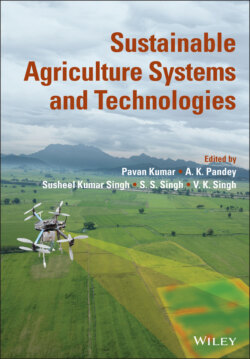Читать книгу Sustainable Agriculture Systems and Technologies - Группа авторов - Страница 31
2.3 Crop Diversification and Ecosystem Services
ОглавлениеGenerally, crop diversification is perceived as a change from the regional supremacy of one crop to regional production of number of the crops to meet ever increasing demand of cereals, pulses, vegetables, fruits, oilseeds, fibers, fodder, grasses, etc., of the human and livestock population. Crop diversification also guarantees higher profits for the growers. It also aims to improve soil health and to maintain dynamic equilibrium of the agroecosystem. Furthermore, in India crop diversification is generally viewed as a shift from traditionally grown less remunerative crops to more remunerative crops. In the present context, the unsustainability of the modern agricultural system, there lies high stack on crop diversification mainly due to disturbance in the ecosystem. The sustainability of agricultural production system can be achieved by maintaining ecosystem services, with the design of appropriate crop diversification plans specific to agro climatic conditions. From Figure 2.1, it can be well understood that among all the agricultural operations/practices, the crop diversification including the agricultural diversification has a greater role to play in maintaining the ecosystem services.
The agroecosystems provide ecosystem services through improved human interventions which have no or very little pressure on environmental resources, ensure recycling of waste products and support large biodiversity as maintained under natural, unmanaged ecosystems. The ecosystems are vital for survival of all living beings. The genetic diversity of crops and livestock, soil health maintenance, and the provision of water sources are some of the very important supporting ecosystem services. Whereas, the regulating services of the ecosystems are in the form of pollinators, which ensures better seed setting, and the presence of the natural enemies control the crop pest within agro‐ecosystems. Natural ecosystems also filter water and normalize its flow into agricultural systems. Therefore, crop diversification create favourable conditions for smooth functioning of the ecosystem services. This ultimately improves the overall health of the ecosystem which are essential for survival and well‐being of mankind. It also ensures enhanced floral and faunal diversity, better pollination, natural pest management, efficient nutrient cycling, soil fertility, and water regulation without compromising on crop yields. Sustainable agronomic management targets above and below ground biodiversity, ensures better pest management, improved water regulation, enhanced nutrient cycling, and improved soil health.
Figure 2.1 Crop diversification maintains many of the ecosystem services and hence also maintains the resilience in the production systems.
Figure 2.2 (a) Functional biodiversity delivering ecosystem services (e.g. pollination, natural biocontrol) in support of crop yields along a gradient of crop diversification and ecological infrastructure and (b) alternative options (efficiency, substitution, redesign) for farm management systems situated on a continuum from conventional agricultural intensification to ecological intensification.
(See insert for color representation of the figure.)
Even under stressed ecologies (poor soil fertility, dry land scenario, abiotic, and biotic stresses), the crop diversification and growing of large number of crops are widely recommended to reduce the risk factor of crop failures. For the majority of farmers in different parts of the country, the gains from application of scientific tools and technologies in agriculture are yet to be realized. On realization, it will help in greater expansion of crop diversification in many areas. It is hard fact that the productivity levels of many major crops in India do not match with the yields obtained in agriculturally advanced countries even under predominant rice–wheat system. On the other hand, as a result of growing few crops in large areas, many problems in the forms of increasing biotic and abiotic stresses are emerging. Therefore, diversification of predominant cropping system in India will bring the new dawn of prosperity and resilience in agricultural production system. Therefore, efficient and effective crop diversification is a crucial for the sustainability of Indian agriculture.
